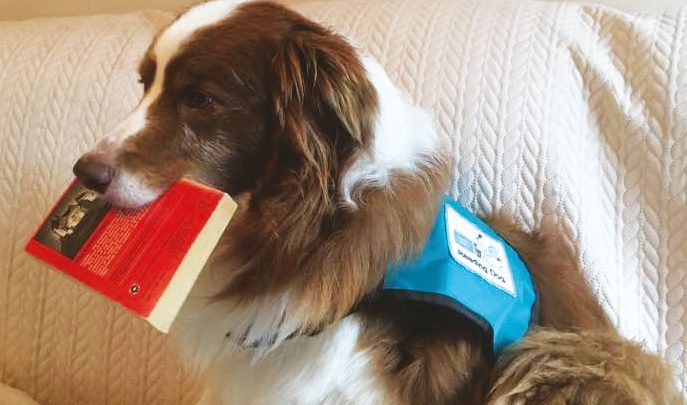Improve Your School’s Literacy Outcomes with Dog Visits

Dr Helen Lewis explores whether dogs can have a role to play in shaping pupils’ attitudes to learning and level of engagement

The relationship between humans and dogs has endured for many thousands of years.
The benefits of this partnership have long been recognised – psychologist Sigmund Freud, for instance, noted that his dog Jofi helped patients relax during therapy sessions.
The 19th-century poet Shelly once wrote that, ‘The psychological and moral comfort of a presence at once humble and understanding – this is the greatest benefit that the dog has bestowed upon man.’
The community-based reading with dogs scheme ‘Burns By Your Side’ (BBYS) is based on the premise that dogs can act as calm, patient and non-judgemental listeners, providing a comforting presence to children who are facing particular challenges with learning.
Around 20 educational settings in South Wales are currently taking part in the scheme, spanning nurseries, primary and secondary schools, further education colleges and libraries, and nearly 30 trained volunteers and dogs are involved.
Children with a wide range of needs – cognitive, personal, social, emotional or behavioural – are selected by their schools to take part, and proceed to work with the same dog and owner on a regular basis.
In evaluating the scheme, it’s worth looking at the impact that reading with dogs has had on pupils’ enjoyment of reading, their attitudes to learning and their view of themselves as successful learners.
Teachers, children, parents and volunteers were asked to reflect on their perceptions of BBYS. In all cases, the children who read to the dogs gave positive feedback, and every school reported its pupils showing great interest in taking part.
Teachers stated that children responded positively to the presence of the dogs and looked forward to the sessions, while the volunteers noticed improvements in the children’s attitudes and engagement, with positive changes in their confidence, enjoyment, engagement and oracy figuring highly.
Here, I’m going to examine how three different settings went about implementing the scheme and how their learners were able to benefit.
Frankie
Stepaside Primary school has around 140 pupils on roll and is visited weekly by Michelle and her dog Frankie. Frankie works with four targeted children every week, selected because they find reading a challenge and are lacking in confidence as learners.
Headteacher Paul Harries says that the children are more relaxed when they read with Frankie, and enjoy the opportunity to ‘Read without interruption and correction.’ The result has been improvements in both their self-confidence and enthusiasm for reading.
Frankie also works with a further four pupils during each visit on a rota basis. Paul had previously noticed that children throughout the school met Frankie with great delight during his visits.
He and the staff therefore decided to allow everyone in school the chance to engage with Frankie, so that over the course of year everyone was able to feel part of the initiative.
Emma and her cockapoo Beau make weekly visits to St Florence Church in Wales VC School, Tenby. They read with selected children in Years 3 and 4 who have low selfesteem and find it hard to enjoy reading. Headteacher Julie Davies is positive about the impact Beau is having, noting that the whole school is very enthusiastic about Beau’s visits, and that the children’s confidence and enthusiasm for reading has improved. Indeed, Julie’s seen Beau’s impact first hand: “I have observed Beau listen to the children read on many occasions, and I always have a lump in my throat when I see him move closer or place his paw next to the child to reassure them.’ The children agree, with one pupil stating that she feels ‘Very excited’ when Beau arrives, and that that he really helps her to learn to read.
Myrddin Special Needs Unit caters for 30 pupils aged 3 to 11 years with profound and severe learning difficulties, some of whom are on the ASD continuum. For two years Carole and her rescued retriever Sally have made weekly visits. Sally works with all the children on a rota basis, with the nature of the activities depending on a child’s individual needs. Some children may just look at or touch Sally, while others groom or read to her. One pupil, 10-year old Lucas, previously found that Sally seemed to enjoy listening to him read the first chapter of The Hobbit. Some of the children carry out simple training routines with Sally, in which they’re required to listen to simple instructions and repeat them so that Sally can earn a treat, thus encouraging their communication skills. Children who are otherwise reluctant to interact with other people will happily interact with Sally. This may take subtle forms, such as making eye contact with her, but it marks a big step forward for them. One of the unit’s teachers, Llinos Thomas, notes that discussion of Sally and her imminent arrival can serve as an incentive for the children to communicate with the teaching staff.
Our study indicates that having the chance to read regularly to a dog can be of benefit to certain children, particularly those with additional learning needs. These benefits are seen across a range of skills and attitudes beyond enjoyment of reading. Communication skills, confidence and attitudes towards learning often show improvements. Feedback from schools, pupils and volunteers is overwhelmingly positive. When asked whether they would recommend the initiative, one head wrote ‘Absolutely and without hesitation. The impact it has had on our children is a joy to see. When children know it’s their turn to read, their faces light up.’ Dogs, it seems, really can make a difference.
Dr Helen Lewis is PGCE Programme Lead at the University of Wales Trinity Saint David. Further details about the Burns By Your Side scheme are available at burnsbyyourside.org; schools interested in getting involved can email Carol Lincoln at carol@burnspet.co.uk. Sally
In conclusion
Safety steps












